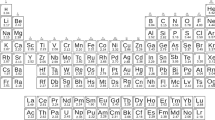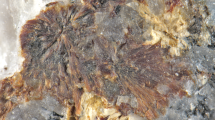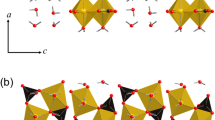Abstract
MATSUI and I have estimated partition coefficients for some elements1–4 and discussed the significance5,6 of estimating them. More recently7, I have estimated partition coefficients for rubidium and strontium. However, we have little knowledge about what conditions affect partition coefficients and to what extent they can be influenced. For example, it is conceivable that temperature and pressure have some effects on them. But results so far obtained suggest that the effects of temperature and pressure are not serious. A difficult problem, however, is the influence of calcium. If magnesium and/or ferrous iron are the overwhelmingly predominant metallic cations in a liquid and a solid separated from it, the relationship between the chemical ‘environment’ and the partition coefficient is very simple. But if calcium is abundantly present its effect is superimposed on that of magnesium. The lower limit of concentration required for the appearance of this calcium effect is, as yet, unknown. However, since the effect is thought to arise when calcium becomes one of the host elements of rock-forming minerals, it is most probable that it occurs when the concentration of calcium in the ‘liquid’ (magma) is enriched to some definite degree. Furthermore, the combined or concurrent effect of calcium and magnesium may reflect the simple atomic ratio in which they are present in crystals. (These possibilities suggest that the apparent change of partition coefficient due to calcium is somewhat discrete.)
This is a preview of subscription content, access via your institution
Access options
Subscribe to this journal
Receive 51 print issues and online access
$199.00 per year
only $3.90 per issue
Buy this article
- Purchase on Springer Link
- Instant access to full article PDF
Prices may be subject to local taxes which are calculated during checkout
Similar content being viewed by others
References
Masuda, A., Nature, 203, 1161 (1964).
Masuda, A., INSJ–65, Inst. Nucl. Study, Univ. Tokyo (1964).
Masuda, A., and Matsui, Y., INSJ–53, Inst. Nucl. Study, Univ. Tokyo (1963).
Masuda, A., and Matsui, Y., Geochim. Cosmochim. Acta (to be published).
Masuda, A., Nature, 204, 373 (1964).
Masuda, A., Nature, 204, 567 (1964).
Masuda, A., Nature, 205, 555 (1965).
Masuda, A., Geochim. Cosmochim. Acta (to be published).
Masuda, A., Nature, 205, 971 (1965).
Schmitt, R. A., Smith, R. H., Lasch, J. E., Mosen, A. W., Olehy, D. A., and Vasilevskis, J., Geochim. Cosmochim. Acta, 27, 577 (1963).
Haskin, L., and Gehl, M. A., J. Geophys. Res., 67, 2437 (1962).
Author information
Authors and Affiliations
Rights and permissions
About this article
Cite this article
MASUDA, A. Variation of Partition Coefficient. Nature 205, 1098–1099 (1965). https://doi.org/10.1038/2051098a0
Issue Date:
DOI: https://doi.org/10.1038/2051098a0
This article is cited by
-
Effect of Co-ordination Number on Lanthanide Abundance Variation
Nature (1966)
-
Primeval Strontium-87/Strontium-86 Ratio
Nature (1965)
Comments
By submitting a comment you agree to abide by our Terms and Community Guidelines. If you find something abusive or that does not comply with our terms or guidelines please flag it as inappropriate.



